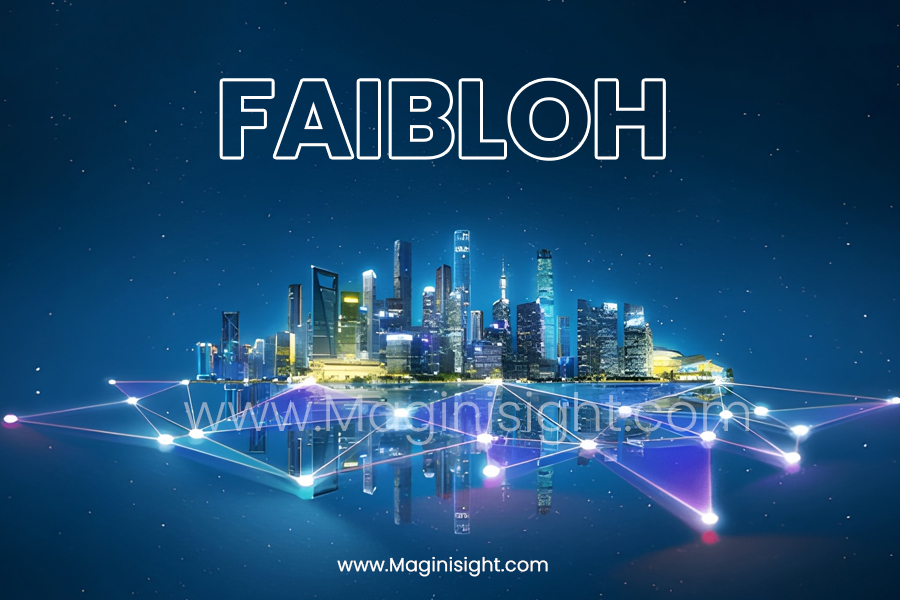In the simplest terms, Faibloh is the intelligent bridge between artificial intelligence, the Internet of Things, blockchain, and sustainability. It isn’t a single app or gadget—it’s a smart digital framework designed to connect, automate, and optimize how modern systems work together. Think of it as the foundation of a smarter, greener, and more efficient digital world.
At its core, Faibloh combines advanced algorithms, connected devices, and eco-friendly architecture into a single, adaptive digital system. By integrating AI, IoT, and blockchain, it creates an environment where technology learns, predicts, and evolves without constant human oversight. In essence, Faibloh represents the next generation of sustainable digital infrastructure—a living ecosystem capable of making industries more productive and environmentally responsible at the same time.
This article examines the comprehensive landscape of Faibloh—how it operates, the technologies that drive it, its applications, and why it’s considered one of the most promising examples of technology-driven sustainability today.
The Core Concept of Faibloh
The heart of Faibloh lies in its connected digital architecture—a design that allows different technologies to communicate seamlessly. Instead of operating in isolation, every component of the system—whether AI software, IoT device, or blockchain ledger—works as part of an integrated technology ecosystem.
1. A Smart Digital Framework Built for Adaptability
Faibloh’s architecture is modular and scalable. This modular digital system means organizations can start small and expand as their needs grow, achieving system scalability without heavy restructuring. From cloud servers to edge devices, each element in Faibloh’s network supports interoperable digital platforms that cooperate in real time.
The system adapts dynamically, using autonomous decision-making powered by AI to analyze data streams from IoT sensors, predict trends, and optimize performance. It’s an adaptive smart system that reacts instantly to changing conditions—whether that means reducing energy consumption, rerouting logistics, or adjusting industrial output.
2. Designed Around Sustainability
Unlike many traditional digital solutions, Faibloh embeds eco-friendly digital design principles directly into its foundation. This approach results in energy-efficient technology that reduces power consumption while maintaining performance. The use of green data centers, low-power computing, and sustainable IT architecture ensures a smaller carbon footprint across operations.
In practical terms, Faibloh embodies responsible digital transformation. It aligns with ESG-compliant solutions, addressing environmental and social governance requirements that are now central to corporate and government policy. Every element of Faibloh is built to support sustainable operations that balance innovation with ecological awareness.
3. Transparency and Trust by Design
One of Faibloh’s strongest advantages lies in its use of blockchain technology as a digital trust layer. By recording every transaction or system action on a decentralized data security framework, Faibloh guarantees data transparency and trust. The use of immutable transaction records prevents tampering and ensures accountability—critical in sectors such as healthcare, logistics, and finance.
Through this combination of autonomy, transparency, and sustainability, Faibloh positions itself as a sustainable innovation platform that’s ready for the challenges of a connected world.
Key Technologies Powering Faibloh
To understand why Faibloh is reshaping industries, we need to look closely at the four pillars that support it: Artificial Intelligence, Internet of Things, Blockchain, and Sustainability. Each technology contributes a vital layer of functionality, and together they create a powerful, unified system.
Artificial Intelligence (AI): The Cognitive Engine
AI forms the brain of Faibloh’s ecosystem. It transforms raw data into actionable intelligence through machine learning algorithms, predictive analytics, and AI-driven optimization. Using model predictive control (MPC) and cognitive computing, the system anticipates outcomes before they occur and adapts accordingly.
For example, in manufacturing environments, Faibloh’s AI analyzes production data to perform predictive maintenance, preventing costly downtime. In energy networks, it uses AI-based sustainability techniques to forecast energy demands and manage consumption in real time. These AI-driven optimization processes enhance both operational efficiency and energy efficiency optimization, cutting waste while increasing productivity.
The integration of artificial intelligence (AI) also supports autonomous decision-making—allowing the system to perform tasks without manual control. From traffic management to supply-chain logistics, Faibloh’s AI capabilities lead to faster, more accurate, and more sustainable outcomes.
Internet of Things (IoT): The Sensory Network
If AI is the brain, IoT represents the senses of Faibloh. A network of IoT-enabled smart sensors collects real-time data monitoring information from environments, machinery, and infrastructure. These connected devices ecosystems feed the AI layer with accurate and continuous inputs, forming a foundation for intelligent automation.
In a smart building automation scenario, Faibloh uses IoT data to regulate lighting, heating, and ventilation, leading to measurable reductions in energy consumption. The system’s IoT energy management features allow facilities to maintain comfort levels while reducing cost and emissions. In agriculture, precision farming technology and IoT-driven agriculture tools measure soil moisture, temperature, and crop health—helping farmers optimize yields while using fewer resources.
The industrial IoT (IIoT) applications extend these advantages to manufacturing, where real-time equipment monitoring supports automation and scalability across complex operations. With each device feeding into the same network, Faibloh builds a connected digital architecture that improves efficiency from the ground up.
Blockchain Technology: The Layer of Trust
Transparency and accountability are central to Faibloh’s success. The use of blockchain technology ensures that every process and data transaction is traceable and secure. This distributed ledger solution forms a tamper-proof record that supports compliance, auditing, and ethical management.
Each data block within the decentralized architecture is protected through blockchain-based encryption, ensuring secure digital transactions. In addition, decentralized data protection minimizes the risk of centralized breaches—a major advancement for cybersecurity. This creates a framework for cyber resilience that aligns with modern regulatory standards.
The blockchain component also enhances blockchain transparency across various industries. For instance, in logistics, blockchain for smart grids or smart logistics tracking enables supply-chain participants to verify data instantly, eliminating fraud and increasing trust. Similarly, carbon credit tracking powered by blockchain helps organizations measure and offset emissions accurately, further reinforcing Faibloh’s sustainable mission.
By integrating blockchain into its integrated technology ecosystem, Faibloh supports trustless digital security—a key requirement for organizations transitioning to digital operations.
Eco-Friendly Design: The Sustainable Core
Faibloh stands apart through its deep commitment to sustainability. Unlike other smart frameworks, its eco-friendly digital design extends beyond software efficiency—it influences hardware selection, data-center operations, and even code optimization. The goal is to minimize environmental impact while maintaining high performance.
By combining green data centers, low-power computing, and renewable energy optimization, Faibloh helps reduce the carbon footprint of digital operations. This design philosophy also encourages environmental impact mitigation through AI-assisted analytics that identify inefficiencies across supply chains and industrial processes.
What makes Faibloh particularly innovative is its alignment with ESG-compliant solutions and sustainable tech evolution. In a world where technology contributes significantly to global emissions, Faibloh provides a blueprint for responsible innovation—offering both progress and preservation.
Interconnectivity and Cloud-Edge Synergy
A defining feature of Faibloh’s architecture is its cloud-edge integration, allowing data to be processed closer to where it’s generated. This approach improves real-time analytics and reduces latency, leading to faster responses and lower energy consumption. By distributing workloads between centralized and edge resources, the framework achieves high efficiency and resilience.
This synergy enhances automation and scalability, giving businesses the flexibility to expand without compromising performance. It also ensures that enterprise system compatibility remains intact—whether Faibloh is linked to existing ERP platforms, CRM tools, or industrial control systems.
Security and Privacy: Built-In Defense
Security is not an afterthought in Faibloh; it’s part of its DNA. The combination of AI-driven cybersecurity and blockchain-based encryption delivers multi-layered protection. Proactive threat detection powered by AI identifies vulnerabilities before they’re exploited, while blockchain’s immutable nature safeguards data integrity.
This privacy-focused infrastructure ensures that sensitive information remains secure, making Faibloh particularly suitable for sectors such as healthcare, finance, and government. Its approach to data transparency and trust balances openness with confidentiality, creating an ethical model for responsible digital transformation.
How Faibloh Works in the Real World
While the technology behind Faibloh is advanced, its real strength lies in its practical impact. It’s not an abstract digital concept—it’s an operational framework that brings together intelligent software, connected hardware, and sustainable energy practices to drive measurable change across multiple sectors.
Faibloh operates through a three-layer system:
-
Data Collection Layer – IoT devices and smart sensors capture real-time data.
-
Cognitive Processing Layer – AI algorithms analyze and interpret this data.
-
Blockchain Validation Layer – Secure ledgers store verified information, ensuring transparency and trust.
Together, these layers create an autonomous, self-correcting digital ecosystem that can function across industries with minimal human intervention.
Let’s explore how Faibloh transforms key industries through innovation, connectivity, and sustainability.
Faibloh in Healthcare: Smart, Secure, and Predictive
In healthcare, Faibloh has become a game-changer by making medical processes more efficient, secure, and data-driven. It bridges the gap between patient care and digital intelligence through a network of smart devices and AI analytics.
1. Streamlined Patient Care
With Faibloh’s AI-driven analytics, hospitals and clinics can analyze patient histories, diagnostic data, and treatment responses in real time. This allows for personalized treatment planning and early intervention for critical cases. Smart IoT devices continuously monitor vital signs—heart rate, blood pressure, oxygen levels—and instantly send updates to physicians through Faibloh’s connected healthcare platform.
This system enhances remote patient monitoring, reduces hospital readmissions, and empowers both patients and healthcare providers with real-time information.
2. Secure Medical Data with Blockchain
Security is one of healthcare’s biggest challenges. Faibloh addresses this through its blockchain-backed data protection system. Every medical record is stored as an encrypted, time-stamped block that cannot be altered without authorization. This creates a tamper-proof medical database where doctors, hospitals, and insurers can verify information instantly.
The combination of blockchain transparency and decentralized security not only ensures patient confidentiality but also streamlines compliance with health data regulations like HIPAA and GDPR.
3. AI for Predictive Health Insights
Using AI-driven healthcare analytics, Faibloh predicts potential health risks by analyzing massive datasets. For example, it can detect early signs of chronic conditions like diabetes or cardiovascular disease based on subtle behavioral and biological patterns.
In public health, Faibloh’s predictive systems assist in identifying outbreak patterns, optimizing resource allocation, and enhancing emergency response planning. It turns healthcare into a proactive, rather than reactive, system.
Faibloh in Manufacturing: From Automation to Intelligence
The manufacturing industry is at the heart of the digital revolution, and Faibloh plays a central role in making Industry 4.0 truly intelligent.
1. Predictive Maintenance and Reduced Downtime
Faibloh’s AI continuously processes data from factory equipment through industrial IoT (IIoT) sensors. These sensors detect early signs of malfunction—like vibration changes, overheating, or power fluctuations—allowing predictive maintenance before a breakdown occurs. This not only prevents costly downtime but also extends equipment lifespan.
2. Smart Automation and Robotics
Faibloh enhances automated manufacturing systems by integrating AI-powered robotics with real-time IoT feedback. Machines can autonomously adjust production speeds, quality parameters, or material use depending on demand and system conditions. This leads to smart production optimization that balances speed, quality, and sustainability.
3. Energy Efficiency and Resource Management
Manufacturing consumes vast energy, but Faibloh introduces sustainable production analytics to monitor consumption in real time. By analyzing data across machinery, lighting, and cooling systems, it identifies inefficiencies and automatically adjusts power usage. This makes factories eco-efficient, aligning them with ESG standards.
Through AI-driven process control, Faibloh helps manufacturers reduce waste, improve quality, and achieve energy-efficient manufacturing systems that minimize environmental impact.
Faibloh in Agriculture: Precision Meets Sustainability
In agriculture, Faibloh has introduced the concept of smart, data-driven farming that improves productivity while preserving natural resources.
1. IoT-Enabled Smart Farming
Sensors embedded in the soil and atmosphere collect data on temperature, humidity, and soil composition. This data is processed by Faibloh’s AI to determine precise irrigation and fertilization needs—reducing waste and maximizing yield. This approach, known as precision farming technology, ensures crops receive exactly what they need at the right time.
2. Blockchain for Supply Chain Transparency
From field to market, Faibloh’s blockchain-based supply chain ensures that every agricultural product’s journey is fully traceable. Consumers can verify where their food came from, how it was grown, and whether it meets sustainability standards. This enhances food safety and consumer trust across global supply chains.
3. Climate Adaptation and Environmental Management
Using predictive analytics, Faibloh can forecast weather changes and crop performance under different conditions. This allows farmers to prepare for droughts, floods, or pest infestations. It’s a powerful example of how AI and IoT-driven agriculture can adapt to the realities of climate change while safeguarding food security.
Faibloh in Smart Cities: The Future of Urban Living
As cities grow, managing resources efficiently becomes a major challenge. Faibloh introduces a connected digital infrastructure that transforms cities into smart, adaptive ecosystems.
1. Energy-Optimized Infrastructure
Through IoT energy management, Faibloh coordinates lighting, traffic signals, and utilities to reduce waste and emissions. Smart sensors adjust public lighting based on daylight levels and pedestrian activity, while AI optimizes energy use across buildings and transportation systems.
This AI-driven sustainability approach helps cities lower operational costs while meeting environmental targets.
2. Intelligent Transportation Systems
Traffic congestion and pollution are key urban problems. Faibloh’s AI-based traffic management analyzes real-time vehicle data to control signals, optimize routes, and reduce idle times. Its blockchain-verified transport networks enhance coordination among public and private transport systems, improving the commuter experience.
3. Waste and Water Management
Faibloh extends its IoT integration to waste and water systems. Smart sensors detect fill levels in waste bins or monitor water quality in real time, triggering timely responses. This intelligent monitoring system promotes eco-friendly urban living and supports long-term sustainability goals.
Faibloh in Finance and Business: Transparency and Trust
Financial systems thrive on security and trust—two principles deeply embedded in Faibloh’s blockchain infrastructure.
1. Secure Digital Transactions
Faibloh uses blockchain-based payment verification to ensure that transactions are transparent, instantaneous, and tamper-proof. This enhances security while eliminating intermediaries, reducing transaction costs and delays.
2. Fraud Prevention and Compliance
Through AI-powered fraud detection, Faibloh identifies unusual patterns across digital networks, preventing identity theft and money laundering. Its decentralized auditing systems also simplify compliance with regulatory frameworks.
3. Data Integrity and Enterprise Integration
Businesses can integrate Faibloh into their existing ERP and CRM systems, achieving a unified enterprise data ecosystem. This streamlines workflows, improves decision-making, and supports data-driven business intelligence.
By promoting transparent digital governance, Faibloh enables businesses to operate with confidence in a rapidly changing digital landscape.
Benefits of Using Faibloh
The implementation of Faibloh across industries delivers both operational and environmental benefits that extend beyond mere automation.
1. Enhanced Efficiency
Through AI-driven automation, Faibloh reduces manual processes, boosts accuracy, and accelerates productivity. Real-time monitoring ensures that systems adjust themselves dynamically to optimize output and minimize waste.
2. Cost Reduction
By combining predictive analytics with energy-efficient systems, organizations save significant costs on maintenance, power, and logistics. Reduced downtime and smarter resource allocation contribute to long-term financial sustainability.
3. Transparency and Accountability
Blockchain technology ensures that every digital process is recorded and verifiable. This promotes trust between businesses, consumers, and regulators—a core requirement in today’s data-driven economy.
4. Environmental Sustainability
Faibloh is not just about smart technology—it’s about sustainable innovation. Its green architecture minimizes energy use, reduces carbon emissions, and supports global environmental goals.
5. Scalability and Flexibility
Faibloh’s modular design means it can adapt to small startups or large enterprises alike. As needs grow, new layers and modules can be integrated without disrupting existing operations.
Challenges and Considerations in Implementing Faibloh
While Faibloh represents the next generation of smart, sustainable digital infrastructure, it isn’t without its challenges. Every technological shift—especially one as comprehensive as Faibloh—comes with strategic, financial, and ethical considerations. Understanding these helps organizations prepare for smoother, more responsible adoption.
1. Initial Setup Costs and Infrastructure Readiness
The first hurdle many companies face with Faibloh is infrastructure compatibility. Integrating AI, IoT, and blockchain requires high-speed connectivity, sensor networks, secure cloud storage, and data processing hardware.
These components demand initial capital investment, particularly for traditional industries transitioning from legacy systems. However, the long-term returns—through reduced energy use, automated efficiency, and sustainability compliance—often outweigh these early expenses.
Forward-looking organizations can mitigate these challenges through phased implementation, starting with pilot programs or single-department deployments before scaling up across the enterprise.
2. Data Integration and Interoperability
One of Faibloh’s strengths—its ability to unify diverse technologies—can also pose integration difficulties when systems operate on incompatible protocols or formats.
Many older systems store data in siloed environments, making interoperability a significant obstacle. Faibloh addresses this through open APIs and modular architecture, but successful integration still requires data mapping, migration, and harmonization processes.
Organizations must also establish data governance frameworks to maintain consistency, accuracy, and compliance across systems. The solution lies in creating a standardized data ecosystem where all devices and platforms communicate seamlessly.
3. Skills and Workforce Transformation
Adopting Faibloh means adopting a new way of thinking. Employees need training in AI-driven operations, IoT management, and blockchain analytics.
Rather than replacing human workers, Faibloh enhances their capabilities—shifting focus from repetitive tasks to decision-making, analysis, and system oversight. Upskilling programs and digital literacy initiatives are crucial for successful transformation.
Forward-thinking organizations view Faibloh not as a threat to jobs, but as a tool for empowerment—where humans collaborate with intelligent systems to achieve higher productivity and creativity.
4. Ethical and Privacy Concerns
Ethical responsibility is central to Faibloh’s development. Since it processes massive amounts of real-time data, questions arise regarding privacy, consent, and data ownership.
To address these, Faibloh incorporates blockchain-based identity verification and AI ethics protocols that govern how data is collected, processed, and shared. Each transaction or decision is transparent and traceable, ensuring compliance with global privacy standards like GDPR and ISO 27701.
Still, organizations using Faibloh must establish internal ethical committees or oversight boards to continuously review data practices. The goal isn’t only to use data—but to use it responsibly, securely, and for positive social impact.
5. Cybersecurity Threats in a Hyperconnected World
As more systems connect through IoT and blockchain, cybersecurity becomes paramount. While Faibloh’s decentralized architecture offers built-in protection, no digital ecosystem is entirely immune from risk.
AI-driven threat detection mechanisms monitor for anomalies, but organizations must still implement multi-layered defense strategies—including encryption, access control, and constant monitoring.
Faibloh’s blockchain foundation, however, gives it a significant advantage over traditional architectures: immutable ledgers make tampering almost impossible, and decentralized verification prevents single points of failure.
Ethical and Environmental Impact of Faibloh
1. The Pursuit of Digital Sustainability
Unlike many digital frameworks that prioritize performance at any cost, Faibloh was designed with sustainability at its core. Every layer—from hardware utilization to data routing—is optimized to reduce carbon footprint and energy waste.
For instance, Faibloh-powered data centers can lower energy consumption by up to 30–50%, depending on workload and cooling systems. AI algorithms dynamically manage power distribution, ensuring no system consumes more energy than necessary.
This aligns with the global push for green computing and carbon-neutral technology ecosystems—a major focus for corporations adopting ESG (Environmental, Social, and Governance) frameworks.
2. Responsible AI and Fairness
AI systems, if unchecked, can reflect bias or make opaque decisions. Faibloh mitigates this through its transparent AI governance model, where every algorithmic decision is logged, reviewed, and traceable through blockchain.
This creates an auditable trail that ensures fairness and accountability in automated decision-making. It also allows organizations to verify that AI outcomes align with ethical guidelines and human values.
3. Environmental Monitoring and Climate Action
Beyond optimizing internal efficiency, Faibloh contributes to global environmental monitoring systems. Through IoT networks and predictive AI, it helps track air and water quality, monitor forest health, and forecast extreme weather events.
Governments and environmental agencies can use Faibloh to develop early-warning systems for natural disasters, improving both preparedness and resilience. This showcases how technology can serve humanity’s broader ecological responsibilities.
The Future of Faibloh: Trends, Innovations, and Global Potential
The evolution of Faibloh is just beginning. Its architecture is flexible enough to evolve alongside emerging technologies—positioning it as the foundation for next-generation digital transformation.
1. Integration with Quantum Computing
As quantum computing advances, Faibloh is poised to integrate quantum AI processing to handle complex simulations and big-data analytics at unprecedented speeds.
Quantum algorithms will enable Faibloh to analyze energy systems, traffic networks, and industrial operations millions of times faster, unlocking optimization potential never before possible.
2. Edge and Fog Computing Expansion
To reduce latency and reliance on centralized servers, Faibloh’s framework will increasingly adopt edge and fog computing models. These allow data to be processed closer to the source—whether in a factory, a vehicle, or a hospital—enhancing responsiveness and reliability.
This approach is particularly beneficial for real-time applications such as autonomous vehicles, remote surgery, and smart grid control systems.
3. Cross-Industry Collaboration and Ecosystem Growth
Faibloh’s modular nature allows it to evolve beyond individual enterprises. In the near future, collaborative Faibloh networks could interconnect entire industries—energy, transportation, manufacturing, and finance—into unified, interoperable ecosystems.
This cross-industry collaboration would lead to unprecedented data transparency, shared innovation, and global sustainability alignment.
4. Human-AI Collaboration and Augmented Intelligence
Rather than replacing humans, Faibloh will continue fostering human-AI symbiosis—where AI augments human creativity and problem-solving abilities. In workplaces, employees could interact with Faibloh’s intelligent assistants to make strategic, data-backed decisions faster and more accurately.
This vision represents the next evolution of augmented intelligence, where humans remain in control but gain superhuman insight through AI’s analytical power.
5. Global Expansion and Smart Economy Transformation
As countries adopt smart city initiatives, Faibloh’s ecosystem will play a pivotal role in powering the global digital economy. Governments are already exploring Faibloh-inspired infrastructure for energy grids, transportation systems, and supply chains that are intelligent, sustainable, and transparent.
By 2030, experts predict that systems like Faibloh could reduce global industrial emissions by up to 20% through optimized resource management alone. This makes it not only a technological innovation but also a climate solution.
Why Faibloh Represents the Future of Technology
At its essence, Faibloh is more than a digital framework—it’s a philosophy of progress. It symbolizes the union of innovation, responsibility, and sustainability, showing that technology can serve both business growth and planetary well-being.
Unlike traditional systems, Faibloh is living architecture—constantly evolving, learning, and adapting. It provides a bridge between cutting-edge intelligence and real-world needs, helping industries grow without compromising ecological balance.
Its core principles can be summarized as:
-
Integration – Combining AI, IoT, and blockchain into one synchronized system.
-
Transparency – Using blockchain to ensure accountability and trust.
-
Efficiency – Leveraging AI to optimize resources.
-
Sustainability – Reducing waste and supporting eco-friendly operations.
-
Scalability – Expanding easily across different sectors and environments.
In an era where innovation often comes at the cost of ethics or the environment, Faibloh stands as a model of what responsible technology should be—intelligent, transparent, and sustainable.
Conclusion
Faibloh is not just a technological product—it’s a movement toward smarter, cleaner, and more ethical digital infrastructure. Its integration of artificial intelligence, IoT, and blockchain creates a unified system that aligns innovation with environmental stewardship.
From smart cities and healthcare to manufacturing and finance, Faibloh is reshaping industries with a commitment to sustainability and security. It offers a roadmap to a world where technology doesn’t just connect devices—but empowers people, protects resources, and preserves the planet.
As businesses, governments, and innovators continue to adopt Faibloh, one thing becomes clear:
The future of technology is not only about being smarter—it’s about being kinder, greener, and more transparent.
Be the first to know! Stay tuned for fresh updates and timely notifications. Mag Insight!










